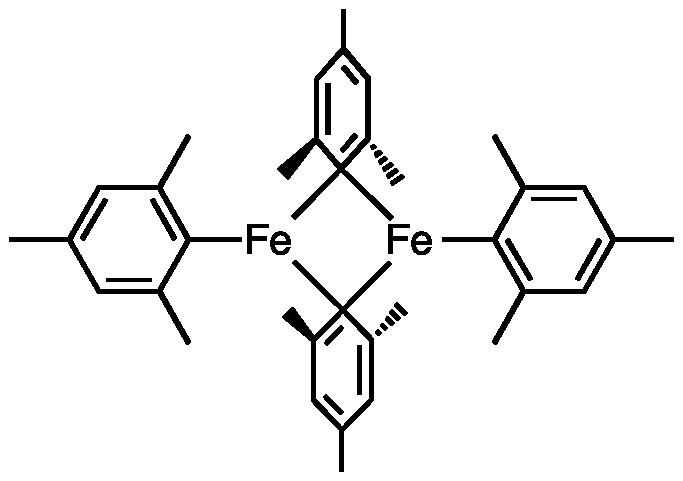 | ||
Organoiron chemistry is the chemistry of iron compounds containing a carbon-to-iron chemical bond. Organoiron compounds are relevant in organic synthesis as reagents such as iron pentacarbonyl, diiron nonacarbonyl and disodium tetracarbonylferrate. Iron adopts oxidation states from Fe(-II) through to Fe(VI). Although iron is generally less active in many catalytic applications, it is less expensive and "greener" than other metals. Organoiron compounds feature a wide range of ligands that support the Fe-C bond; as with other organometals, these supporting ligands prominently include phosphines, carbon monoxide, and cyclopentadienyl, but hard ligands such as amines are employed as well.
Contents
- Alkyl and aryl compounds
- The binary carbonyls and their anions
- DieneFeCO3 derivatives
- Sulfur and phosphorus derivatives
- Ferrocene and its derivatives
- Fp2 and its derivatives
- Polyhapto organic ligands
- Phosphine and amine FeII complexes
- Organoiron compounds in organic synthesis and homogeneous catalysis
- Biochemistry
- References
Alkyl and aryl compounds
The simple peralkyl and peraryl complexes of iron are far less developed than are the Cp and CO derivatives. Examples of compounds in this class are Fe(norbornyl)4 and tetramesityldiiron.
The binary carbonyls and their anions
Important iron carbonyls are the three neutral binary carbonyls, iron pentacarbonyl, diiron nonacarbonyl, and triiron dodecacarbonyl. One or more carbonyl ligands in these compounds can be replaced by a variety of other ligands (dienes, phosphines).
Iron carbonyls have been used in stoichiometric carbonylation reactions, e.g. for the conversion of alkyl bromides to aldehydes. Disodium tetracarbonylferrate, "Collman's Reagent," can be alkylated followed by carbonylation to give the acyl derivatives that undergo protonolysis to afford aldehydes:
LiFe(CO)4(C(O)R) + H+ → RCHO (+ iron containing products)Similar iron acyls can be accessed by treating iron pentacarbonyl with organolithium compounds:
ArLi + Fe(CO)5 → LiFe(CO)4C(O)RIn this case, the carbanion attacks a CO ligand. In a complementary reaction, Collman's reagent can be used to convert acyl chlorides to aldehydes. Similar reactions can be achieved with [HFe(CO)4]− salts.
(Diene)Fe(CO)3 derivatives
Iron diene complexes are usually prepared from Fe(CO)5 or Fe2(CO)9. Derivatives are known for common dienes are cyclohexadiene, norbornadiene and cyclooctadiene, but even cyclobutadiene can be stabilized. In the complex with butadiene, the diene adopts a cis-conformation. Iron carbonyls are used as a protective group for dienes in hydrogenations and Diels-Alder reactions. Cyclobutadieneiron tricarbonyl is prepared from 3,4-dichlorocyclobutene and Fe2(CO)9.
Cyclohexadienes, many derived from Birch reduction of aromatic compounds, form derivatives (diene)Fe(CO)3. The affinity of the Fe(CO)3 unit for conjugated dienes is manifested in the ability of iron carbonyls catalyse the isomerisations of 1,5-cyclooctadiene to 1,3-cyclooctadiene. Cyclohexadiene complexes undergo hydride abstraction to give cyclohexadienyl cations, which add nucleophiles.
The enone complex (benzylideneacetone)iron tricarbonyl serves as a source of the Fe(CO)3 subunit and is employed to prepare other derivatives. It is used complementarily to Fe2(CO)9.
Alkynes form many compounds with upon reaction with iron carbonyls. These include cyclobutadiene derivatives, ferroles" of the formula Fe2(C4R4)(CO)6, as well as cyclopentadienone and cyclobutadiene derivatives.
Sulfur and phosphorus derivatives
Complexes of the type Fe2(SR)2(CO)6 and Fe2(PR2)2(CO)6 form, usually by the reaction of thiols and secondary phosphines with iron carbonyls. The thiolates can also be obtained from the tetrahedrane Fe2S2(CO)6.
Ferrocene and its derivatives
The rapid growth of organometallic chemistry in the 20th century can be traced to the discovery of ferrocene, a very stable compound which foreshadowed the synthesis of many related sandwich compounds. Ferrocene is formed by reaction of sodium cyclopentadienide with iron(II) chloride:
2 NaC5H5 + FeCl2 → Fe(C5H5)2 + 2 NaClFerrocene displays diverse reactivity localized on the cyclopentadienyl ligands, including Friedel-Crafts reactions and lithation. Ferrocene is also a structurally unusual scaffold as illustrated by the popularity of ligands such as 1,1'-bis(diphenylphosphino)ferrocene, which are useful in catalysis. Treatment of ferrocene with aluminium trichloride and benzene gives the cation [CpFe(C6H6)]+. Oxidation of ferrocene gives the blue 17e species ferrocenium. Derivatives of fullerene can also act as a highly substituted cyclopentadienyl ligand.
Fp2 and its derivatives
Fe(CO)5 reacts with dicyclopentadiene to give the cyclopentadienyliron dicarbonyl dimer ([FeCp(CO)2]2). Reduction of this species with sodium gives "NaFp" (Fp = [FeCp(CO)2]−), a potent nucleophile and precursor to many derivatives of the type CpFe(CO)2R. Fp can also be synthesized photochemically using UV-Visible light. The derivative [FpCH2S(CH3)2]+ has been used in cyclopropanations. Fp-acyl compounds are prochiral, and studies have exploited the chiral derivatives CpFe(PPh3)(CO)acyl. Pyrolysis of Fp2 gives the cuboidal cluster [FeCp(CO)]4.
Polyhapto organic ligands
Stable iron-containing complexes with and without CO ligands are known for a wide variety of polyunsaturated hydrocarbons, e.g. cycloheptatriene, azulene, cyclooctatetraene (COT), and bullvalene. The compound Fe(COT)2 is well known, Fe3(COT)3 was described in 2009 as the reaction product of Fe(COT2 with a catalytic amount of an persistent carbene. It can be regarded as an organic version of triiron dodecacarbonyl.
Phosphine- and amine-Fe(II) complexes
As for other organometallic compounds, organoiron(II) complexes in the absence of Cp ligands are commonly complemented by tertiary diphosphines and to a lesser extent amine/imine ligands. Complexes of the type FeX2(diphosphine)2 figure prominently in this area, provided early examples of C-H bond activation, dihydrogen complexes, and dinitrogen complexes. Complexes derived from Schiff bases are active catalysts for olefin polymerization.
Organoiron compounds in organic synthesis and homogeneous catalysis
Because of its low cost and low toxicity of its salts, iron is often employed as a stoichiometric reagent. Iron's role as a catalyst in organic reactions is overshadowed by the related chemistries of cobalt and nickel. Some main categories are:
Biochemistry
In the area of bioorganometallic chemistry, organoiron species are found at the active sites of the three hydrogenase enzymes as well as carbon monoxide dehydrogenase.
